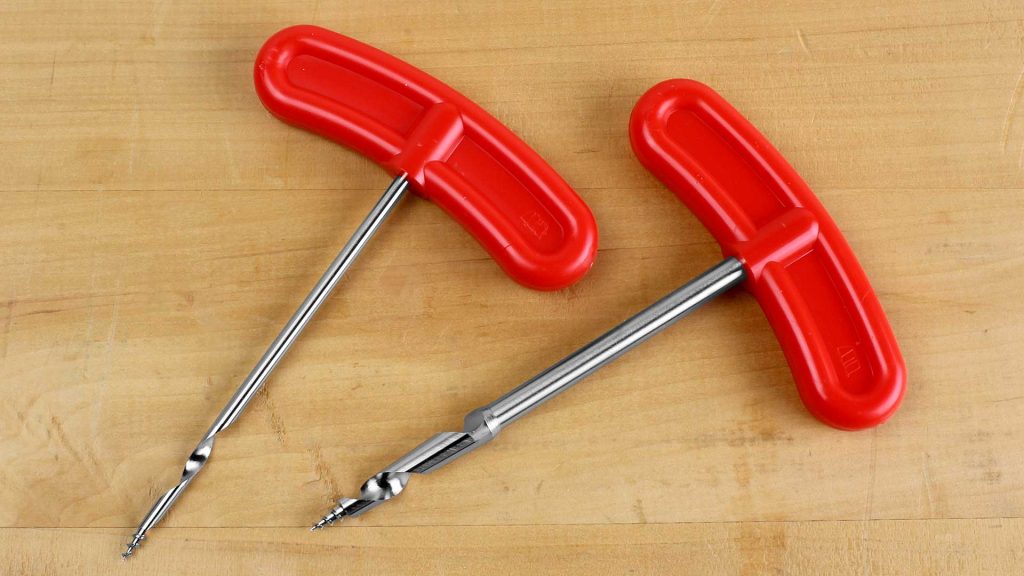Are you wondering how a gimlet tool can be useful? Is it not quite clear what is a gimlet tool made of and whether or not you need one?
Many people, especially those who love DIY, pose this question, and to give you an answer, we will tell you all you need to know about the gimlet tool. This includes the history behind it, how to use it, how to sharpen one, and the difference between it and the auger and awl tools.

What Is a Gimlet Tool?
The general use of this tool is to make small holes, mainly in wood, without splitting it. These small holes act as pilot holes for screws. The gimlet tool has been around for more than two centuries and was invented sometime in the mid-1850s.
The name gimlet is derived from the French word “guimbelet”, which means “to bore” or “to twist”. In the modern French language, it is also called “vrille”, which signifies tendril.
A more technical definition of a gimlet tool is “a piece of steel of a semi-cylindrical form, having a cross handle at one end and a worm or screw at the other, and is hollow on one side”(Joseph Gwilt 1859).
Read more: What Is a Tarp Made Of?
What’s It Made Of?
Gimlet tools are most often made from hardened steel. When it was first invented centuries ago, it had a twisted metal handle, was made from one entire piece, and was very inconvenient to use.
Today, gimlet tools are made and machined with high precision, with the body still made from steel, while the handle is either made from wood or high-quality plastic.
If the entire body of the gimlet is made from one steel piece and then the handle is covered with plastic, its durability is substantially increased because it ensures that the handle won’t break and separate from the body with force.
How to Use a Gimlet Tool
Using a gimlet tool is very straightforward. Its point is shaped similarly to an auger tool, and it only requires initial pressure to be applied before it starts boring.
Once the tool “catches” the wood and starts drilling, all you need to do is twist it in a clockwise direction, and it will do the job by itself. The auger-type point is there to clean any excess wood shavings the tool makes, which results in effortless drilling.
If the wood is softer, then a minimal initial pressure is required, but if it is hardwood, like oak or walnut, then you will need to press and twist harder for the tool to make the initial entry and start drilling.
How to Sharpen a Gimlet Tool
Sharpening a gimlet tool is possible, even though its size is quite small. However, special needle files are required to sharpen it properly, and it is a process that requires a bit of patience. Once you sharpen a gimlet tool, it will perform a lot better, and you will also extend its lifespan.
Sharpening the tool requires that only one side of it be filed down. The side that needs to be filed is usually the inner one, inside the spiral part of the body.
The correct way to sharpen the spiral knives is to perform an outward motion with the file between the spiral openings. This will make the spiral knives sharper, and the tool will bore a hole easier and without much effort.
Read more: How to Sharpen a Hatchet With a Stone

Differences Between a Gimlet Tool, an Auger Tool, and an Awl
The main difference between a gimlet tool and an auger is their size. A gimlet is usually very small and meant for puncturing tiny pilot holes for screws, while an auger can vary in size and is meant for drilling larger holes in wood for different purposes.
Another difference between a gimlet and an auger can be the tip and body construction. Namely, the gimlet can only have a threaded tip and a spiral knife body, while an auger tool always has both.
On the other hand, when you compare a gimlet tool with an awl, the difference is apparent.
An awl is a needle-type, pointed instrument used for piercing small holes, mainly in leather, while the gimlet has a threaded tip meant for boring holes in wood. You can also use an awl to mark a surface before cutting it to size. Leatherworkers mostly use awls, while gimlets are used by carpenters who need high precision.
Read more: What Is in a Mess Kit?
What Is a Gimlet Tool’s Use in the Wild?
It is always a good idea to carry a gimlet tool with you if you plan to camp in the wilderness.
For example, it can help you drill small holes in custom wooden tent pegs to which you can attach the tent string. It can also prove helpful for drilling holes in fabric if you need to. It pierces leather very easily and without effort as well.
If you have a cabin in the woods and need to perform repairs, a gimlet tool is a small but great addition to your arsenal. For example, if the cabin door needs adjustment, you can easily bore new pilot holes for the hinge screws using a gimlet tool.
Conclusion
A gimlet can be a very useful addition to your arsenal, especially if you’re into precision woodworking. Even though it may look simple and outdated, it still has many important uses, which is why many experienced craftsmen constantly use it.
